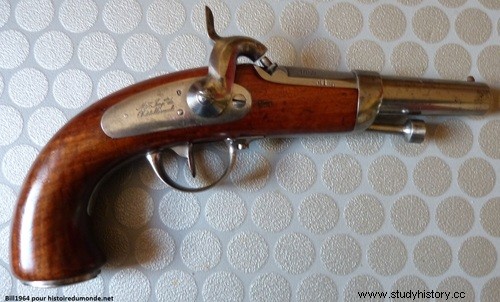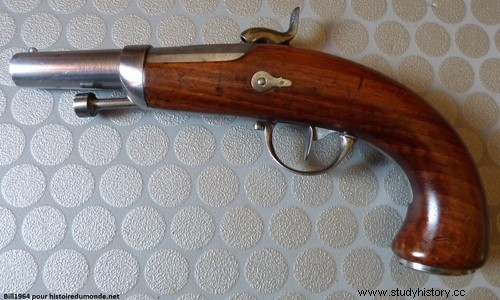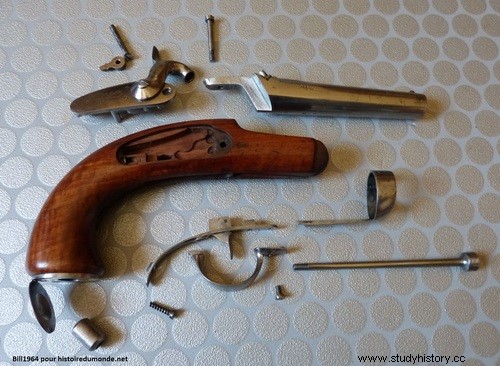
Repeating the tradition of model 1770 pistols, the gendarmerie established a model particular for the use of its officers, it was the 1836 model.
At that time it was a particularly modern weapon, the military weapon was still with the flintlock system and the smooth barrel; this pistol designed from its origin with a percussion system and rifled barrel was therefore an innovation, but not a first since these characteristics are already found on the model 1833 cavalry officer's pistol.
L he weapon is said to be half-apple because of its short length, it uses the so-called 26 bullet (26 bullets cast from a pound of lead); it is the only ½ pommel pistol, whether troop or officer, to have a rifled barrel. In this field, the Gendarmerie officer's pistol model 1836 is resolutely innovative, like that of the Cavalry officer's model 1833 with which it also presents certain design similarities; the other regulation weapons will indeed have to wait around 1860 to see their rifled barrels.
The 1836 pistol is a meticulously manufactured weapon but without any decorative research, unlike other models of pistols from officers (model l 833 or model 1855).
A strictly regulatory and functional weapon, the 1836 pistol was only manufactured by State factories; only the Maubeuge factory until its final closure in 1837, then that of Châtellerault produced this rare model.
Manufacturing started under the July Monarchy continued under the Second Republic and then the Second Empire; there are therefore examples whose locks are signed Manufacture Royale, Manufacture Nationale or Imperiale and the barrels dated accordingly.
The production volumes are not known with precision, but have been relatively modest; the whole, from 1836 until the gradual withdrawal from service around 1873-1874, must not exceed 1500 to 2000 copies, at the most.

Some indications on the weapon in addition to the photos:
The barrel has a narrowed chamber and is rifled with 36 "hair" stripes running from left to right. Its caliber is 15.2 mm to receive a spherical bullet 14.7 mm in diameter and weighing 18.5 g, the bullet is driven into the barrel with gentle friction with the only force applied manually on the ramrod .
The capsule (or primer) used is of the so-called "hunting" or commercial type.
The powder is loaded using a small pod screwing onto the stick, this pod is housed under a hinged cap covering a cavity in the stock; this cavity can also receive a spare funnel.
The plate is of a so-called Pontcharra shape, held by a single front screw, the rear part being held in the stock by means of a hook taking under an axis integrated in the wood.
The “Pontcharra” turntable is characterized by its flat body and its substantially ovoid shape. It only has the hammer on the outside and the mechanisms on the inside are simplified and pushed to the rear according to the principles of the percussion system.
This type of lock will also equip the first version of the Model 1833 Officer's Pistol, the Model 1837 Carbine and the Model 1838 Rampart Rifle.

Technical parenthesis concerning the percussion system:
Fruit of the progress of the industrial revolution, the percussion system constituted an important stage in the techniques of armament during a rather short period (1840-1866 if one excepts the pistols of officer of cavalry officer model 1833 and 'officer of the model 1836 gendarmerie and the model 1837 rifle), but which represents the pivotal period between the flintlock models and the bolt-action models still in use today.
The principle of firing by percussion, as simple as it is clever, results above all from progress in chemistry from the end of the 17th century and throughout the 18th century, however, loading weapons by the mouth remained the rule.
This new system was the result of research on "fulminant" powders with a view to priming, which led around 1800 to the development by the English engineer Howard of mercury fulminate whose essential property is to detonate at c hoc.
All that remained was to adapt the technique to exploit the capabilities of the product; Here again, it was across the Channel that the thing materialized, thanks to a Scottish pastor named Forsyth, a lover of weapons and a great hunter, who filed a patent for it in 1807.
Everything rested simply on the firing of the propellant charge contained in the barrel, by the shock on an external primer taking the form of a brass capsule lined inside with a pellet of fulminate of mercury highly sensitive to shock.
Waste not being in the spirit of the times, the conversion of the old flintlock systems to the new mode of firing was essential; it was simple and the modifications to be made only concerned two parts of the weapon, the rear of the barrel and the lock.
It can be summarized as follows:
The lock:
Reduced from its external mechanisms that have become useless, it only has a dog in the shape of a curved hammer intended to produce the shock on the primer. The internal mechanisms, if they were simplified in the new fabrications, could be kept as they are in the transformed flintlock weapons; those on the outside being limited to the single hammer, the location of the bascinet being filled by a machined and added part.
The barrel:
As part of the transformations, the old light was filled in and the barrel was drilled on the left side to adapt a screwed weight communicating directly with the chamber and surmounted by a removable chimney which received a consumable capsule (or primer) when firing. For new manufactures, the hammer was forged and formed an integral part of the barrel.
Compared to the old flintlock system, there was thus a notable simplification and above all a considerable improvement in the tightness of the priming and therefore in the safety of the firing. The first "new" models were produced in 1840. The transformations of the earlier models, mainly of the 1816 and 1822 models but also of the Year IX for the last productions or the examples still in good condition, began in the same period of time ( this explains why the 1816 and 1822 models are very rare these days in their original flintlock version).
Generalized from 1840, the percussion system was supplanted in 1866 by the Chassepot mobile breech; the Franco-Prussian War of 1870, however, prolonged its longevity somewhat since the withdrawal from service, for certain models, does not seem to have been effective until around 1875. The actual existence of percussion weapons, if we take into account counts the first model for officer (model 1833) will thus have been only about forty years before the universalization of the bolt action rifle and the revolver, weapons still in service today in modernized versions. This same period will see the progressive generalization of the rifling of barrels, a principle which will become the rule for all small and large caliber weapons.
